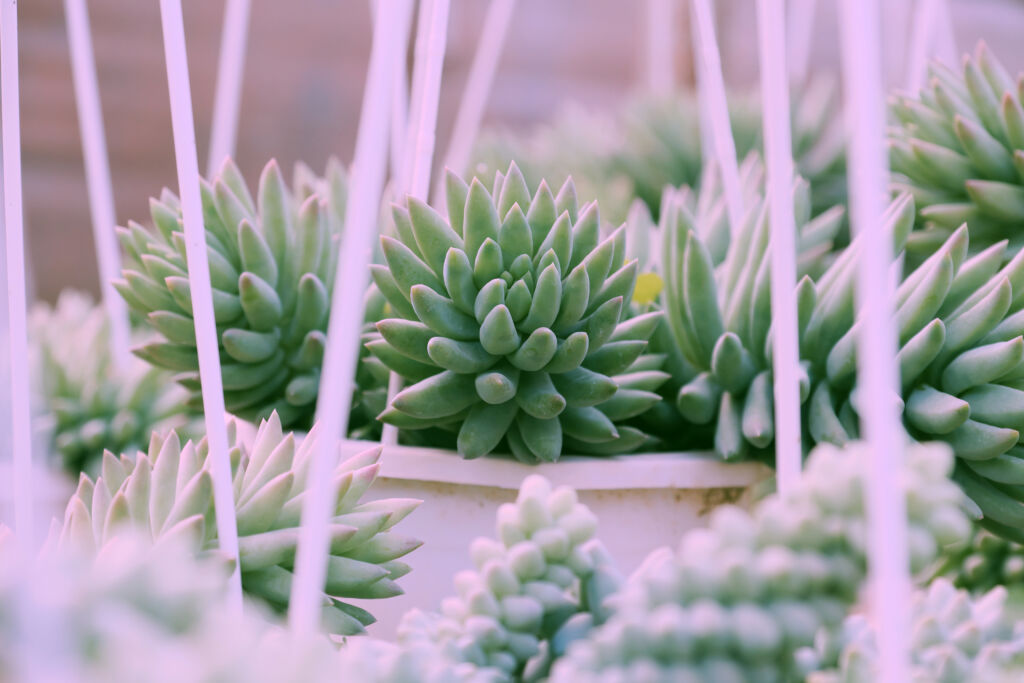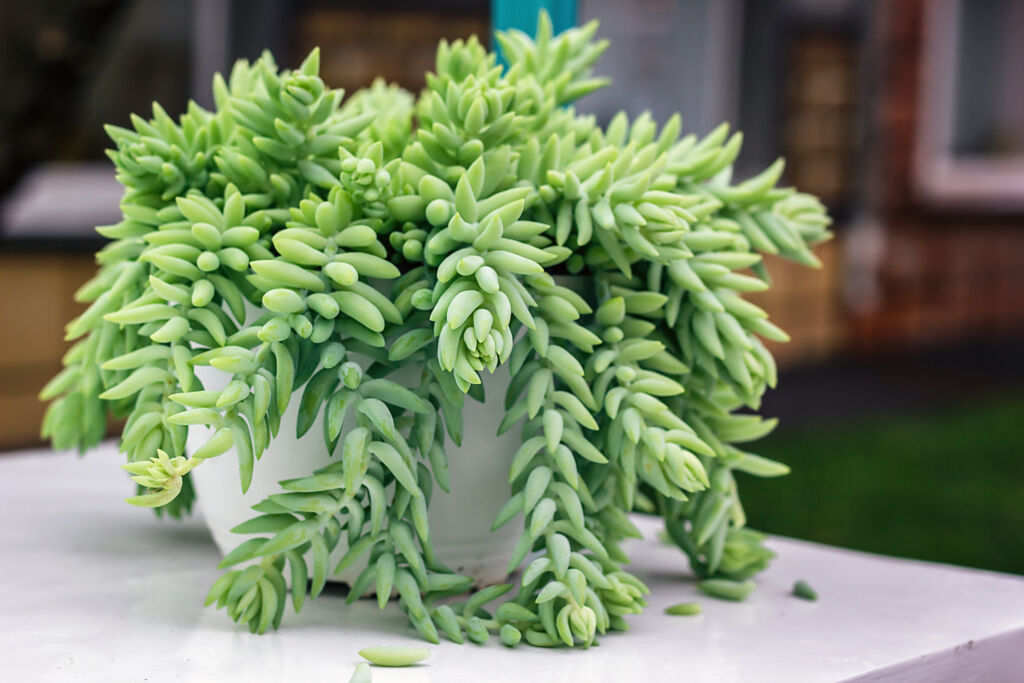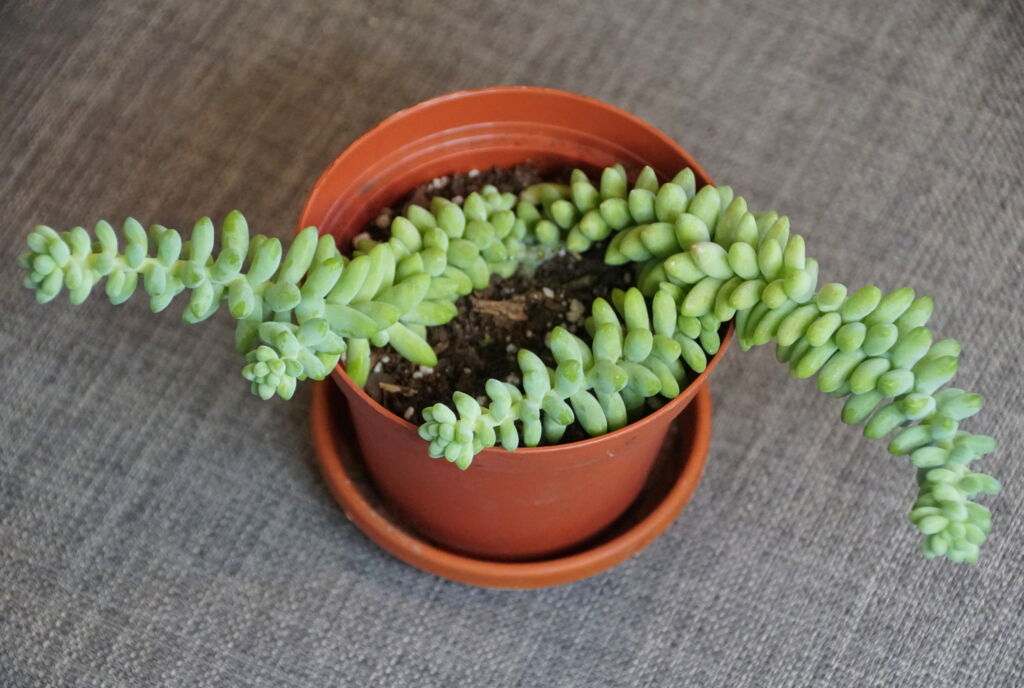HousePlantJoy is supported by our audience. When you purchase through one of our links, we may earn a small affiliate commission. As an Amazon Associate I earn from qualifying purchases. Your cost is not affected.
==================
Burros’ tail houseplant (or Donkey tail succulent) is a popular and easy-to-grow succulent. This delicate succulent’s simple and straightforward nature makes it one of the easiest houseplants to own. With its elegant trailing stems and easy propagation, Burro’s succulent trail can be a lovely addition to your succulent collection.
Donkey Tail Succulent
Remember that many gardeners think Burro’s tail is a cactus which is not valid. While all cacti can be succulents, not all succulents are cacti. However, both have a lot of similar requirements, such as good drainage, gritty soil, sunshine, warm temperatures, etc.
Growing Donkey tail succulent provides a beautiful texture as a graceful houseplant with blue-green tear-drop-shaped leaves in many landscapes.
About Burro’s Tail Houseplant
If you have a burro’s tail in your houseplant collection, you will agree that it can be tricky to grow, especially indoors. While the succulent belongs to a substantial sedum family, the Donkey tail houseplant is fragile and can quickly lose its leaves. It loves flirting with sandy soil and morning sunlight.
Succulent in a Pot
Moreover, as a succulent trailing perennial, the Donkey tail produces up to 2-foot long stems covered with densely packed knob-like blue-green leaves. A healthy burro’s tail leaves grow very closely together, covering overlapping spots.
Furthermore, these succulents are often grown as potted plants and suspended as hanging specimens. For indoor growing, it is easy to plant and propagate these succulents year-round. Similarly, outdoors, it is best to plant these succulents in early spring. Additionally, remember that the plant rarely blooms indoors, but when it does, it produces pink or red flowers late in summer.
| Common Names | Burro’s Tail, Donkey’s Tail, Lamb’s Tail |
| Botanical Name | Sedum Morganianum |
| Type | Succulent, Perennial |
| Size | Up to 4-Foot Long and 2-Foot Wide |
| Soil | Sandy, Loamy |
| Sun | Partial, Full |
| pH | Neutral, Alkaline |
| Bloom Season | Summer |
| Flowers | White, Yellow, Red |
| Native Area | North America |
How to Care for Donkey Tail Succulent?
As mentioned earlier, Burro’s tail houseplants are easy-to-grow and pretty tolerant. Like most other succulents, they grow well even if you leave them slightly neglected. Additionally, they will still be fine if you forget to water for a couple of days.
Burro’s Tail Houseplant
However, it doesn’t mean they don’t need your attention at all. They require a bit of care while handling. Remember that their stunning beaded stems are incredibly fragile and can break easily, even with the slightest touch. Therefore, we highly recommend choosing a sunny location to place your succulent or hang it and then forget about it.
· Burro’s Tail Houseplant Light Requirement
Like most other succulents, Donkey Tail houseplant also thrives best in warm, sunny conditions, though you can also place it in partial shade. If you want to add it to your indoor houseplant collection, choose a sunny windowsill to provide it with several hours of sunlight.
On the other hand, if you want to grow it outdoors, place your succulent in a pot and find a location with plenty of morning sunlight. It would be best to choose a location with partial shade to protect your plant from aggressive afternoon sunlight.
· Soil Requirement of Donkey Tail Succulent
Proper soil is another critical requirement to keep your succulent happy and thriving. For healthy growth, house it in sandy, well-draining soil. If you want to grow it in a container (either indoors or outdoors), use a gritty soil mixture made explicitly for succulents and cacti.
Moreover, if you want to make your Burro’s tail houseplant a part of your garden, place it amongst other plants in well-drained soil. It will help avoid retaining too much water that can kill your plant. However, if the soil you are using has poor drainage, you should consider mixing sand to aid drainage. Also, remember that these succulents prefer soil with a neutral to alkaline pH.
· Water Requirement of Burro’s Tail Houseplant
When it comes to watering your Donkey Tail, less is more. Like many other succulents, Burro’s tail is incredibly drought resistant once it is established. It also means succulents need water more frequently during spring and summer because that’s their growing season. During winter and fall, reduce watering to avoid water retention and root rot.
For indoor growing, opting for a single heavy watering once a month would be best. However, for outdoor growing, increase the watering frequency once every two to three weeks for outdoors. In this regard, a good rule of thumb is ensuring the soil dries out utterly in-between watering.
Moreover, I highly recommend using a terracotta container or pot with drainage holes at the base to aid in drainage. Additionally, you can also use clay pots to wick water from the soil. Note that while the Donkey tail succulent retains moisture in its leaves and can tolerate drought, overwatering can kill your plant.
· Temperature and Humidity
Burro’s Tail houseplant thrives in tropical environments all year round. However, unlike other plants that require warm temperatures, Donkey Trail is also tolerant to cooler temperatures. Whether you are growing it outdoors or indoors, provide a temperature between 65F and 75F. However, these succulents can tolerate temperatures as low as 40F for shorter periods, but you should protect them from frost or avoid placing them near a window during cold temperatures.
Moreover, these succulents thrive in moderate humidity and can rot if the humidity rises. It means you should avoid keeping your Burro’s Tail in humid environments like a bathroom. In addition to that, they also need bright light. Keeping your succulents in low light conditions or direct sunlight during summer can turn them yellow.
· Fertilization for Donkey Tail Succulent
You don’t necessarily need to fertilize your succulent to keep it healthy and thriving. However, feeding your plant is beneficial and will not cause any harm. If you want fertilizer, ensure to use it during their growing season. It is also best to use a controlled-release fertilizer with an even ratio of potassium, phosphorus, and nitrogen (20:20:20 ratio).
Moreover, while younger succulents need a fertilizer with less nitrogen, mature succulents may need only ¼ of their strength. Another natural way to encourage the healthy growth of your Burro Tail succulent is to use worm casting or compost in the soil. Furthermore, remember to feed your plant once a month and avoid feeding it during the winter.
· Pruning Your Burro’s Tail Houseplant
We often see succulents as small plants because that’s how these plants are sold in nurseries. However, many succulents can grow quite large (i.e., up to 5 feet or more). Keeping their size and densely packed stems, Donkey Tail succulent is a heavy houseplant. So, if you plan to grow it in a container, use a solid pot that can support this beast.
Also, be extra careful and choose an appropriate hanging basket if you plan to grow it in a hanging basket. Even using the right pot, the plant may get a bit rowdy. So it is best to use clean shear to clip back uninvited stems. In addition, be careful and avoid removing more than a third of the succulent at once. Furthermore, if you notice a wounded limb, keep it dry as long as possible until they heal.
· Propagation of Burro’s Tail Houseplant
You can implement many techniques to propagate your succulents. For instance, you can collect seeds for sowing, but they are hard to germinate. The most effective way to propagate your succulent is to use its leaves in spring or fall.
In this regard, choose a whole leaf from a healthy plant, cut it off with a sterilized knife, and then lay it flat on humid soil with the base close to the soil. Keep it at a suitable temperature (25C) and light (scattered light) for a week until you see a new bud growing.
Repotting Your Burro’s Tail Houseplant
Remember that succulents with long, breaded stems like Burro’s Tail grow well in tall containers or hanging pots. They need to trail down freely to showcase their elegance. So, it is essential to use terracotta or clay pots to wick moisture away to avoid root rot.
Burro’s Tail Houseplant
It’s challenging to repot your Donkey’s Tail succulent because the plant is exceptionally prone to damage foliage. Still, if you want to transplant it, do so in spring and make sure you have a larger pot.
When Should Your Repot Your Donkey Tail Succulent?
Changing your succulent pot should be carried out after the cool weather in autumn. However, if the temperature is too high, adjusting to a new jar will be challenging. Once you repot your plant, it needs strictly controlled watering. Moreover, watering your plant after it leaves wilt can encourage healthy growth.
I highly advise avoiding changing the pot during summer because of the high temperatures. Repotting your plants in summer when high temperatures can lead to leaf loss and severe seedling death. So, the best time to repot your Burro’s Tail houseplant is during spring or autumn.
Debasing your Burro’s Tail
Since the branches of your plant are long and more susceptible to damage, it is hard to remove the pot. So, first of all, put the flowerpot on a large table and then sort out its branches. Additionally, since you haven’t changed the pot for a long time, the flowerpot and soil are together, and you have to disperse their connection.
I recommend using a scarifying shovel to move back and forth along the inner wall to cut the connection between the pot and the plant. Now, incline the pot downward to take the mud mass out.
· Clean the Roots
Once you have removed your plant, use a pair of gloves to remove the soil mass. Now, wash the roots with clean water. You can trim and cut off rotting or aging roots with a scissor dipped in alcohol. Once you are done, prepare a disinfectant solution and soak the roots. Take them out and leave them to dry before putting them in a basin.
· Upper Pot Cultivation
Lastly, prepare some fertile peat soil and mix it with perlite and granular vermiculite. The higher proportion of peat soil is excellent for encouraging the growth of new jade. Once the soil is mixed, leave it in the sun for a couple of days for sterilization.
Now, you are ready to plant your Burro’s Tail houseplant in the basin. I also recommend sprinkling some organic fertilizer at the bottom of the basin. After putting on the pot, compact the soil and pour some water to fix the root. Place the new jade in a cool, ventilated spot to adapt to the new soil.
Pests and Diseases
As mentioned earlier, Burro’s Tail houseplant leaves can fall off easily. However, it doesn’t mean that your plant is unhealthy. When leaves fall off, ensure to remove them from the soil and utilize them for propagation.
While many succulents can turn red in bright conditions, Donkey Tail’s succulents don’t boast this protective pigment, making its blue-green leaves susceptible to sunburn. If your plant is received excessive sunlight, it can force your plant to wrinkle up and lose its stem and leaves color.
Burro’s Tail Houseplant
In such a circumstance, immediately move your plant to somewhere else with shaded light. Since the damaged leaves are less likely to recover, prune them away for propagation purposes.
Some common factors that can affect the growth of your Burro’s Tail houseplant include:
· Pests
Fortunately, these succulents don’t attract many pests. However, if you notice some, they will be aphids. These tiny pests will slurp the sap from your plant, leaving it weak and discolored. Moreover, a large infestation can even kill your succulents.
So, the best you can do is to prevent these pests from showing up at all. You must keep the soil clear and regularly prune any infected or dead plant material. I suggest placing your plant with good airflow to avoid moisture retention between the leaves. Furthermore, if you cannot treat aphids, treat your plant with insecticidal soap, neem oil, or diatomaceous earth.
· Diseases
One of the most worrying factors for succulents is root rot. If the roots are retaining excess water, it can cause root rot. The previous healthy growth of your plant will turn black and mushy with no chance of recovery. However, confronting it in the initial stages can help you save the plant.
If you notice root rot, uproot your succulent immediately, remove all the infected leaves, stems, and roots, and plant your succulents in fresh soil. While the most significant cause of root rot is overwatering, the ground fungus can also be a problem.
Should you consider adding a Burro’s Tail Houseplant?
In fact, many people find them quite delightful! It is a delicate, unique-looking plant that needs little care indoors and outdoors. Since it is an easy-to-grow and low-maintenance succulent, the plant is excellent for beginners and master gardeners.
FAQs
Does Burro’s Tail love full sun?
The beautiful succulent loves sitting in bright, shaded light for up to four hours. However, exposure to scorching sunlight for more extended periods will burn the plant.
Can I Grow Donkey Tail succulent indoors?
Yes! It is possible to grow Donkey Tail indoors in well-draining soil. Since it needs bright, partially-shaded sunlight, keep it near a sunny widow.
Can I mist my succulent?
Mature succulents don’t like misting. They love arid environments, so misting means you are changing the humidity around the plant. This can also cause root rot.












